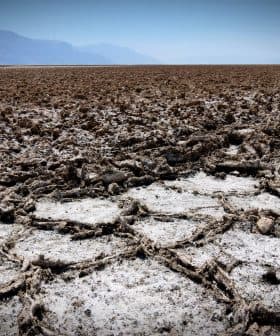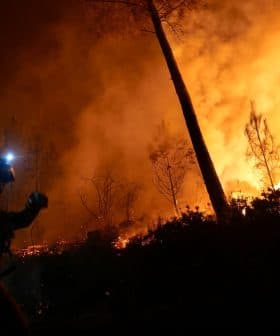Study: Decades of Heatwaves Have Gone Unreported
Heatwaves are increasingly affecting populations and crops globally, with some of the worst heatwaves in recent decades going unreported in countries lacking the means to track such events. Recent studies show that heatwaves are becoming more frequent and lasting longer, with devastating impacts on human health, ecology, and agriculture.
Heatwaves are increasingly affecting population and crops around the globe.
However, new research indicates that the impacts of some of the worst heatwaves in recent decades have gone unreported since they happened in countries that lacked the means to keep track of such events.
Climate change is one of the greatest global health problems of our time, and we have shown that many heatwaves outside of the developed world have gone largely unnoticed.
In a new study published in Science Advances, researchers from the University of Bristol and other academic institutions noted how the extreme June 2021 North American heatwave might be used as a reference to better evaluate the phenomena happening in other parts of the world.
“While it is clear that the event was extreme, it is not obvious whether other areas in the world have also experienced events so far outside their natural variability,” the study authors wrote.
See Also:NASA Climate Scientist Wins World Food PrizeLast summer’s North America heatwave broke several temperature records, including the all-time Canadian high of 49.6 °C in Lytton, British Columbia, on June 29, 4.6 °C hotter than the previous record.
In its press release, the University of Bristol emphasized how the paper analyzed the most intense heatwaves around the world noting how “some of these went almost unnoticed decades ago.”
The researchers found that the western North America heat wave is indeed remarkable as only five other heatwaves were found to be more extreme since 1960.
“We find that in both re-analyses and climate projections, the statistical distribution of extremes increases through time, in line with the distribution mean shift due to climate change,” the scientists wrote. “Regions that, by chance, have not had a recent extreme heatwave may be less prepared for potentially imminent events.”
More specifically, the study, which calculated how extreme heatwaves were relative to the local temperature, showed the top three hottest-ever in the respective regions were in Southeast Asia in April 1998, which hit 32.8 °C, Brazil in November 1985, peaking at 36.5 °C, and the southern U.S. in July 1980, when temperatures rose to 38.4 °C.
“The western North America heatwave will be remembered because of its widespread devastation,” said Vikki Thompson, a researcher at the Cabot Institute for the Environment of the University of Bristol.“However, the study exposes several greater meteorological extremes in recent decades, some of which went largely under the radar likely due to their occurrence in more deprived countries.”
“It is important to assess the severity of heatwaves in terms of local temperature variability because both humans and the natural eco-system will adapt to this, so in regions where there is less variation, a smaller absolute extreme may have more harmful effects,” she added.
According to researchers, heat extremes are a natural part of the climate system but are becoming hotter and longer in duration because of anthropogenic climate change.
The scientists warned that such extremes represent a threat to human health and ecology as their frequency is growing in many regions throughout the globe.
“Excess mortality due to extreme heat is well documented, with an average of six heat-related deaths per 100,000 residents each year in North America estimated for 2000 to 2019,” the scientists wrote. “Heat impacts are magnified in cities, and with nearly 70 percent of the world’s population expected to live in cities by 2050, the risks posed by extreme heat events will also increase.”
See Also:2021 Was Earth’s Fifth Hottest Year, Scientists SayRecent studies confirm that heatwaves are occuring more frequently than in the past and are lasting longer. A recent BBC report found that the number of days with temperatures higher than 50 °C has almost doubled in the last 40 years.
The current heatwave hitting India and Pakistan is taking its toll on the population, as dozens of citizens of both countries died because of the extreme and prolonged heat.
Local authorities believe that the heatwave began seven or eight weeks ago. According to the Indian Meteorological Department, cited by Inside Climate News, March was the hottest recorded month since 1961 in Pakistan.
In northwest and central India, the average maximum temperature throughout April was the highest in over a century.
Heatwaves also take a toll on crop vitality and agricultural output, including olives. Heatwaves have been cited frequently by producers in recent years as reasons why harvests have been lower than expected.
In the 2021/22 crop year, local producers believe that Egypt’s olive output fell up to 80 percent because of the heatwaves. Similar worries at the time were also cited by Sicilian and Moroccan growers.
In the latest Chatham House report on climate change, researchers cited how devastating heatwaves are contributing to a drastic reduction of staple crop yields.
According to the report, the devastating heatwaves are now between 10 and 600 times more likely due to the changing climate. It is believed that at least 3.9 billion people will be severely exposed to such heatwaves by 2040, resulting in 10 million deaths each year from excess heat.
In reference to the study, Dann Mitchell, a professor at the University of Bristol, said “climate change is one of the greatest global health problems of our time, and we have shown that many heatwaves outside of the developed world have gone largely unnoticed.”
“The country-level burden of heat on mortality can be in the thousands of deaths, and countries which experience temperatures outside their normal range are the most susceptible to these shocks,” he concluded.









